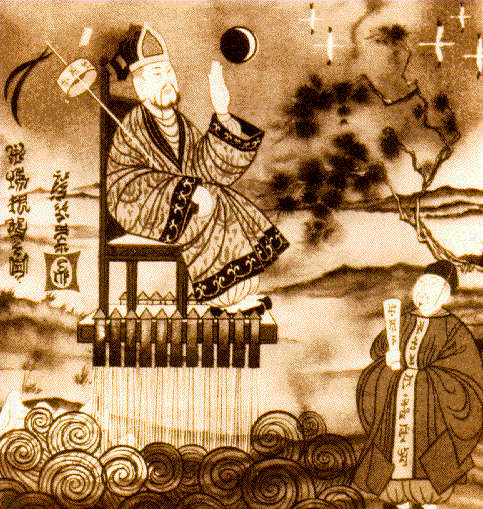Wan Hu appears to be a fictional Chinese official, supposedly in 2000 BC, but this story also recurs during the reign of the Ming Dynasty in China around the 16-th century. According to many 20-th century accounts, Wan Hu seems to be appraised as the world’s first “astronaut” being lifted by rockets into outer space. There is even a crater named Wan-Hoo on the far side of the Moon after this character.
According to the ancient legend, Wan Hu attempted the ambitious flight to the Moon by using a large wicker chair to which were fastened 47 big rockets. He also sought the help of forty-seven assistants, and each of them was armed with torches to light the fuses. Unexpectedly, a tremendous roar accompanied massive clouds of smoke. Once the smoke had cleared out, the flying chair along with Wan-Hu was entirely gone.

An early story of Wan Hu had appeared in an article by John Elfreth Watkins, a civil engineer who worked on the American railroads in the 19-th century. His article was issued in the popular science magazine Scientific American, but instead Wan Hu, the name of the character was Want Tu.
A passage of the article reads as follows: “Tradition asserts that the first to sacrifice himself to the problem of flying was Wang Tu, a Chinese mandarin of about 2,000 years B.C. who, having had constructed a pair of massive, parallel and horizontal kites, seated himself in a chair fixed between them while forty-seven attendants each with a candle ignited forty-seven rockets placed beneath the apparatus. But the rocket under the chair exploded, burning the mandarin and thus angered the Emperor who had ordered a severe paddling for Wang.”
Slightly absurd and comical, the article continues to describe a couple of other fictional stories related to ancient aviators and their courageous attempts. In regards to Wan Hu story, it should also be noted that the given date of 2000 BC pre-dates the appearance of writing in China by few centuries and even more importantly, it pre-dates the invention of gunpowder-based rockets by about three millennia. However, the legend became even more popular as unreferenced accounts of it appeared in Rocket and Jets, written by the American author Herbert S. Zim in 1945.
Despite the fact that the story is widely regarded false by the majority of authorities, Wan Hu found his place in popular culture. The television series MythBusters had attempted to recreate the Wan Hu’s flight by using materials which would have been available to him in an episode aired in 2004. In the experiment, the chair naturally exploded on the launch pad, and the crash test dummy showed what would have been the critical burns.

On the other hand, the Chinese Central Television had announced that Wan Hu was able to lift himself only by a foot using rockets; the TV contribution went in a show about inventions.
Reportedly, in some Chinese versions of the Wan Hu story, he is depicted as an ill-fated pioneer of space travel who instead of becoming the first astronaut in history, was sadly burnt to death because of the explosion which was caused by the rockets.
